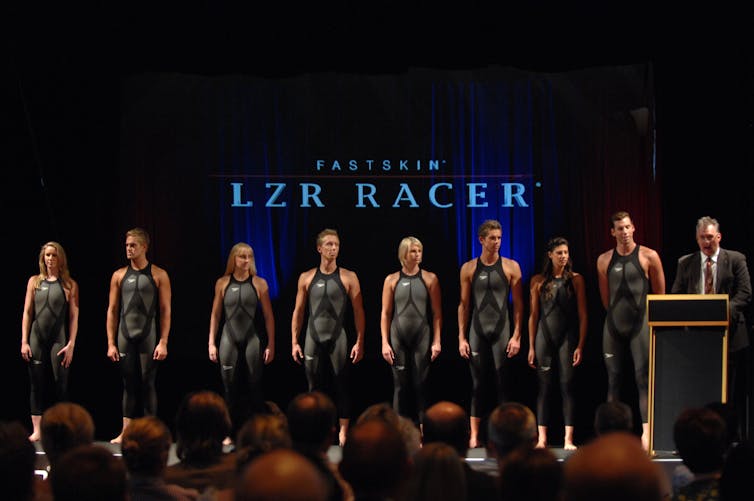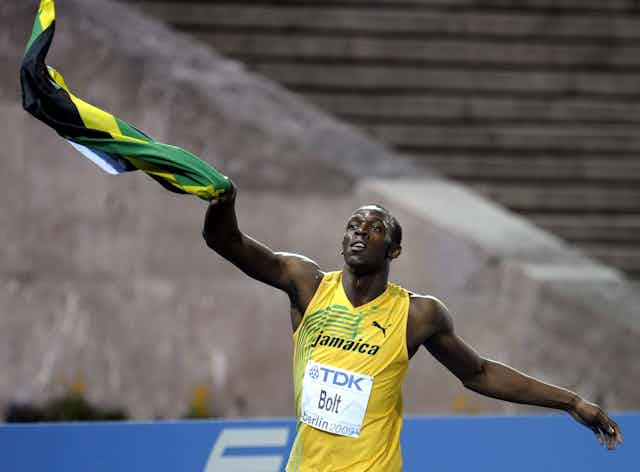We once thought no-one could run a mile in less than four minutes – and yet the current world record stands at three minutes, 43 seconds. So will records keep tumbling as people get fitter and technology takes off? Or is there a limit to human performance?
For physiologists, human performance is limited by the processes involved in energy production and muscle contraction.
Performance in a 100m sprint depends on many processes, including the rate at which energy can be produced and used, the speed at which electrical signals can reach muscles, and the rate at which calcium can initiate muscle contraction and relaxation.
By comparison, marathon performance is dependent on the ability to use oxygen, store and use fat and glycogen for energy, and to keep muscle calcium levels high to maintain contractions. In hot conditions, the ability to sweat is also important for endurance performance.
Based on current knowledge, there should be a limit to these processes, and therefore a limit to human performance. But athletic performance does not depend solely on physiological processes, and improvements in other factors have helped us to far exceed the limits previously placed on human performance.
Causes of athletic improvement
Other factors contributing to athletic performance include psychology, nutrition, training methods and technology. Over the past few decades, leaps and bounds in each of these areas have advanced athletic performance.
Technology is constantly evolving. In swimming, there have been major advances in the design of Olympic swimming pools, reducing turbulence and improving performance. Olympic pools are now deeper, have ten lanes instead of eight, and anti-wave lane ropes.

But it was the advent of “super suits” (pictured above) in 2008 that caused the greatest improvements in performance. The super suits used polyurethane material to reduce drag and improve buoyancy: 255 world records were broken during the two years they were deemed legal.
The suits enabled swimmers to sit in a higher and more streamlined position in the water, and took away the advantage held by swimmers such as Michael Phelps, who naturally sat higher in the water. The suits were finally banned in 2009; but world records set by athletes using super suits have been allowed to remain.
As a result, world records since the super-suit era have been, and will continue to be, few and far between.
Doping and performance-enhancing drugs have been obvious contributors to improvements in athletic performance. As our knowledge of the human body and the processes limiting athletic performance increases, so does the ability to illegally alter these processes to enhance performance.
Gene therapy is now being used to treat diseases associated with muscle wasting and weakness, but it may also be exploited to enhance athletic performance.
Constant improvement
Whether a ceiling to athletic performance will ever be reached depends on many variables, discussed below:
1) The first of these is the type of event. In sprint events - where physiological factors are the main determinant of performance - it’s possible we’ll one day reach a ceiling of human performance.

But this is based on what we currently understand about the limits of physiological and biomechanical performance. There’s a lot about the human body that we still don’t understand, and improvements in our knowledge may reveal new limits to athletic performance.
Performance in endurance events doesn’t just rely on physiology and biomechanics. Because other variables are continuously evolving, it’s likely to take longer for a ceiling to be reached on endurance performance. We may never get there.
2) The answer also involves technology and the limits that are placed on technological advancements. In sports that rely heavily on technology – such as swimming and cycling - a ceiling might not be reached if limits are not placed on the magnitude of performance enhancement that new technology can bring.
3) A third variable involves doping and other illegal performance-enhancing practices. The success of the fight against doping depends on scientists’ ability to come up with tests to detect doping.
This can be problematic when the doping involves manipulating proteins that are normally present in the human body. As long as the authorities remain one step behind those developing the latest doping technologies, it will be difficult for a ceiling on human performance to ever be reached.
4) Finally there are athletes, such as Usain Bolt, who have a physique and running technique we have never seen before, and all of the ceilings that we put on normal physical ability are simply thrown out the window.
There is no doubt improvements in athletic performance have slowed down; but with athletes such as Bolt, and advancements in technology and our understanding of the human body, a ceiling to human performance still seems a long way off.

